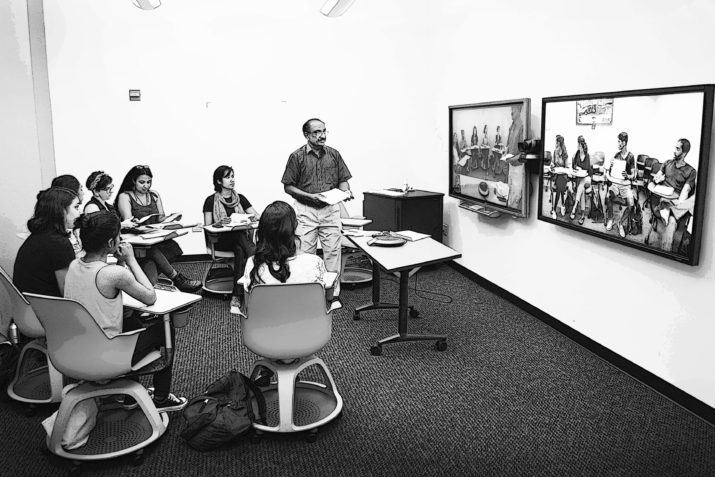

This is part of our special feature on Sustainability & Innovation.
In response to rapidly changing conditions in higher education, an increasing number of institutions of colleges and universities are exploring the potential for collaborative models of course and program sharing to help them meet their academic goals. However, even as we note this development, it is important to remember that while institutions of higher education have collaborated successfully in the past in areas as diverse as information and communication technology, purchasing, registrar functions, security and technical support, study abroad programs, and even research, they are simply not structured to support collaborative approaches that directly impact their core academic mission.
With a small number of notable exceptions (the Five Colleges, the Claremont Colleges, the Northwest Five Consortium, the Five Colleges of Ohio, etc.), the majority of colleges and universities continue to operate today within a culture that portrays each academic mission as distinctly unique, with the prevailing view that all relevant expertise can be – and in fact, should be – found locally on one’s own campus. Accordingly, most are conditioned to see their peers more as competitors than as potential partners, and initiatives that attempt to create academic value across institutional boundaries often run up against entrenched cultures that make it difficult for them to emerge and thrive.
However, there are hopeful signs that higher education might finally be shifting away from this restrictive mindset. There is, broadly speaking, a growing recognition of the intrinsic value of interinstitutional collaboration, which is made increasingly practicable by the evolution of distance-bridging technologies. At the same time, recent changes in the broader educational context (i.e., reductions in state funding, financial and budgetary downturns, shrinking endowments, rising costs, tuition containment, public scrutiny, etc.) have made collaborative strategies a more attractive option for institutions interested in increasing the quality of education, even as they cope with limited or diminishing resources. In this context, collaboration can be a powerful incentive to institute course and program sharing initiatives that leverage resources and expertise among a number of partner institutions in order to help them maintain the full range of course offerings, while at the same time enhancing student learning, advancing interdisciplinarity, expanding curricular choices, and supporting regional initiatives at each of the participating schools.
One initiative that brings a collaborative approach to the teaching of the less commonly taught languages (LCTLs) is the Shared Course Initiative (SCI). Established in 2012 with the generous support of the Andrew W. Mellon Foundation, the SCI is a joint project between Columbia University, Cornell University, and Yale University that synchronously connects classrooms across three sites using high definition videoconferencing, thus supplementing local face-to-face language offerings with instruction delivered via distance. By drawing upon existing resources on each campus, the SCI enables the three institutions to address a number of challenges that have persistently affected the provision and the teaching of the LCTLs in the US.
Broadly speaking, by working to expand the pool of available students interested in studying a particular language, the SCI helps address the issue of chronically low enrollments for many LCTLs at the elementary and intermediate levels, while concurrently increasing the overall range of languages on offer at each of the participating institutions. In turn, a larger pool of students allows the three collaborating institutions to jointly offer instruction beyond the intermediate level, and even begin thinking about offering LCTL courses for specific curricular areas. Such offerings had previously been unfeasible as a result of the endemic shortage of language learners with the required proficiency level to take these courses.
In addition, the SCI allows the three institutions to address another challenge that LCTL programs have persistently faced: the paucity of qualified instructors for many of these languages. This chronic shortfall has meant that institutions, instead of collaborating to share the available teaching talent, have historically competed against one another in an effort to secure these instructors’ services and expertise. By sharing instruction, not only does the SCI address this issue, it also helps reduce costly, counterproductive, and time-consuming efforts to lure away qualified language teachers from one institution to another.
Finally, the SCI helps LCTL instructors integrate more fully into the institutional fabric of each university. By their very nature, appointments in the LCTLs are often specialized and language-focused. Participating in the SCI provides these instructors, who often experience a significant degree of institutional isolation as well as a lack of access to the professional development afforded to instructors of higher enrollment languages, with the opportunity to construct and nurture a community of practice centered around a common pedagogical and programmatic mission. This not only draws together LCTL faculty within and across campuses, it also contributes directly to their development and reflection on the broader topics of best practices for distance education and LCTL instruction in general.
In terms of pedagogy, one important decision that characterizes the SCI model is its commitment to using synchronous, high-definition videoconferencing to connect learning spaces. In a number of pilot projects developed to test proof of concept, an instructor-led approach and synchronicity were both deemed highly desirable. This both reflects the fact that the course content of language classes is highly dynamic, as well as acknowledges the value that our faculty attributes to a learner-driven environment that facilitates a small, highly interactive, multimodal space of instruction capable of fostering exchanges and interactions among class members in a variety of formats. Hence, from the outset, the SCI sought to replicate, at a distance and in real-time, the feel and experience of a face-to-face classroom our faculty associate with quality language instruction. This contrasts sharply with other solutions that exist for course sharing, such as asynchronous online models, or synchronous distributed models that assemble a class with each learner connecting to the shared space using an individual device.
This design approach, which produces the same social expectations and interpersonal dynamics as a traditional class, has been the key to the SCI’s success. SCI classrooms are hybrid, communal spaces in which students can develop the skills required to effectively engage in critical dialogue with both teachers and peers situated both at the home institution and at a remote, partner location. These types of spaces support courses that are, in a sense, “anti-MOOCs,” in that they constitute small, highly-specialized and highly-interactive seminars in which students and faculty can share in the co-creation of knowledge and engage in critical reflection and discussion.
However, the SCI has also shown that the distance format itself engenders a learning environment that differs in several significant ways from that of a traditional, face-to-face classroom. But, these differences should not be conceived of as insurmountable obstacles. Rather, they are opportunities for instructors to draw on their collective pedagogical insights to generate innovative forms of curricular engagement.
Fundamentally, working within this format means that students and instructors must learn to collaborate across distance to negotiate the challenges of co-constructing a shared space of instruction. This necessary collaboration has several beneficial consequences. It leads to a positive recasting of the student-teacher hierarchical model often associated with traditional face-to-face classrooms, and consequently stimulates the emergence of a more collaborative and egalitarian dynamic that promotes active student engagement and shared responsibility. In addition, although both instructors and students typically require a period of adjustment as they engage more fully with and reflect upon the challenges and affordances of the distance environment, they eventually come to develop new practices that fruitfully challenge some of the basic premises of the language classroom. These practices emerge not just as a result of the format’s specificity, but also because the distance mode presents an open and nonrestrictive space of pedagogical exploration that invites active collaboration. In the long run, instructors operating in the SCI model can move away from an “adaptation” approach that relies heavily on previously-deployed face-to-face material, and toward the gradual development of a new course that arises from an extended reflection on teaching in this particular format. Coupled with the support of a community of language professionals, the SCI model can thus spur a healthy refashioning of what may have become a static and routinized pedagogy.
Even though the SCI has been able to help our institutions address some of the challenges that have forced many colleges and universities to reduce the number of LCTLs on offer, its true value at an institutional level might lie elsewhere. Namely, in the fact that it offers an example of academic collaboration that has shown itself capable of helping institutions achieve an effective understanding of the potential for, and the implications of, engaging in collaborative activities more broadly. In this sense, the SCI should not be viewed as a rigid framework that applies only to LCTLs. Rather, it should be seen as a model: a versatile template that functions at multiple levels (institutional, pedagogical, technological, etc.) to help strategic partners think about how they can create shared value across institutional boundaries.
Accordingly, we feel that many of the lessons learned over the past five years could be productively applied to other forms of interinstitutional collaboration. The SCI has convincingly demonstrated that the key factors that make for a successful collaboration over time are flexibility, customization, and a continued willingness to find and implement shared solutions to common challenges. Furthermore, it has shown that developing and establishing a set of core principles is paramount to making the purpose and the intrinsic value of such a program clear and evident to each participating institution.
Two of the major strengths of the SCI model are its replicability, i.e. it can be deployed efficiently and effectively among other institutions, and its adaptability, i.e. how it could be applied to other disciplines or used for different academic purposes. With respect to the first issue, it is heartening to see that collaborative models of instruction are gaining momentum in a broad range of institutional contexts to address the numerous challenges faced by language programs across the nation. A symposium held at Columbia University on April 14-15, 2017, on the theme of “Course Sharing for Sustainable Programs” brought together institutions to showcase a wide range of collaborative initiatives, either directly funded by the Andrew W. Mellon Foundation or modeled on them. The presentations all spoke to a desire to explore how collaborative instruction can offer expanded learning opportunities to students enrolled in language programs. At the same time, while it was encouraging to see so many projects offering solutions for collaboration among institutions with similar profiles, one would hope that collaborative models could also help bridge the gap between institutions of different types (for instance liberal arts colleges and research universities, or two-year and four-year institutions) or between a home institution and its global initiatives.
The second issue, adaptability, raises the larger question of whether collaborative models of instruction have the potential to bring about broader curricular transformation or provide new paths to institutional viability for a wider range of at-risk programs and academic disciplines. The SCI, despite the fact that it was developed to meet the specific challenges associated with the teaching of the LCTLs, can serve as a useful model for developing shared approaches to cross-disciplinary and cross-institutional collaboration. Its established and tested administrative, technological, and pedagogical framework can serve as a working model that can be adapted and applied to other disciplines or areas with a different academic focus beyond LCTL instruction or indeed language instruction in general. Such a model would allow institutions to envision the creation of collaborative, curricular models that would rely on digital technology to effectively bring shared solutions to academic situations where, for instance, lack of enrollments or limited local resources might very well be jeopardizing the viability or the continued existence of a program.
However, this would require departmental and programmatic boundaries to become less rigid, and entail a concomitant shift in curricular and programmatic planning to collaborative and interinstitutional design principles. It would also require a radical change in how colleges and universities think about institutional and departmental autonomy, and could in due course have profound implications for established practices such as curriculum design and faculty hiring.
In conclusion, the SCI is an initiative that was conceived in response to and in consonance with the emerging discourses on collaboration on the Columbia, Cornell and Yale campuses. It focuses on identifying and cultivating new perspectives on the dynamic interplay of global and local knowledge, and seeks to reframe the issue of support for language education from a perspective that resonated with the current institutional mindset about collaborative learning. Faced with ongoing challenges to the continued offerings in the LCTLs at each of these institutions, the SCI provides a collaborative solution facilitated by technology that could be implemented locally to the mutual benefit of all partners. At the same time, it has placed renewed emphasis on effective teamwork, greater cultural and disciplinary variety in student and teacher profiles, and the development of transdisciplinary pedagogical approaches that provide students and faculty with greater opportunities for collaboration and exchange of knowledge.
In tomorrow’s university, all new programs and initiatives, if they are to succeed and indeed flourish, will have to strive to adapt to and abide by the new institutional priorities and strategies articulated in the prevailing administrative discourses. As argued above, collaboration is emerging as one of the salient practices that will shape the environment in which the university will operate in the future. However, in today’s university, which is characterized by a climate of accountability, various players are conceptualizing collaboration simply in terms of seeking efficiencies and optimizing resource allocation. But this mode of thinking about collaboration is too limited and too constrained by economic terms and market considerations.
Fundamentally, collaboration means promoting a culture of cooperation rather than one of competition among strategic partners, and fostering a desire to work across boundaries, whether these are institutional or disciplinary, to devise innovative solutions to common challenges. Institutionally, this means that we need to broaden our understanding of the meaning of collaboration so that it can be recognized not as primarily an answer to financial constraints, but rather as an opportunity to transcend institutional and academic boundaries in order to establish effective and constructive relationships so as to offer high quality, meaningful, and rewarding classes across partner institutions.
To thrive in tomorrow’s environment, institutions have to be prepared to change. They must step out of the comfort zones in which they have hitherto operated autonomously and learn to work productively and beneficially with one another. Collaboration can be a vital lever to enact such fundamental transformational change – the kind of change that is needed if institutions are to successfully confront the challenges they face in the coming years. We believe that the SCI model provides one possible answer to these challenges, one that preserves, and indeed advances the common mission of universities large and small: the education of students.
Stéphane Charitos is Director of the Language Resource Center at Columbia University.
Christopher Kaiser is Program Manager of the Shared Course Initiative at Columbia University.
Nelleke Van Deusen-Scholl is Director of the Center for Language Study at Yale University.
Published on June 6, 2017.




